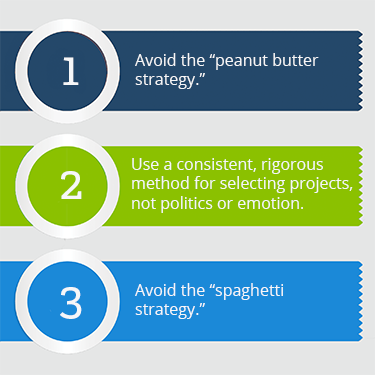Maximize the Value of Your Product Portfolio Through Smarter Investment Spending
- Innovative new offerings that help customers increase revenue and efficiency are required to drive business growth
- Don’t spread your resources too thin, like peanut butter on toast – concentrate resources on a select few best bets
- Don’t invest in innovations all over the map just to see what sticks – tie investments to strategy
For B2B organizations, innovative new offerings that clearly, demonstrably help customers increase revenue and efficiency are required to drive business growth. The question is: What is the best approach to cross-functional agreement on investment spending? At SiriusDecisions, we often speak to product leaders who are struggling to prioritize projects and seeking ways to optimize limited investment dollars.
 At our upcoming SiriusDecisions Summit, Jeff Lash and I will be introducing a new cross-functional model to help companies better allocate investments. Here are a few key principles we’ll cover in our session – called “The SiriusDecisions Investment Decisionmaking Process” – that you can start applying now:
At our upcoming SiriusDecisions Summit, Jeff Lash and I will be introducing a new cross-functional model to help companies better allocate investments. Here are a few key principles we’ll cover in our session – called “The SiriusDecisions Investment Decisionmaking Process” – that you can start applying now:
- Avoid the “peanut butter strategy.” Don’t spread your resources too thin, like peanut butter on toast – concentrate resources on a select few best bets. So many in-market products, services and solutions require ongoing updates that tend to consume a large quantity of investment resources. This often causes resources to be diluted across a range of small, low-payoff projects, starving bigger, high-payoff projects of the dollars they need to be successful. Additionally, go-to-market execution is compromised, as marketing and sales resources must be divided among many initiatives – and the sales team’s ability to fully adopt offerings is undercut by the demands on them. Certainly, focus on core market projects that are critical to the business, but take care also to fully fund several high-reward or longer-term projects in the pipeline. We recommend using tools such as the SiriusDecisions Innovation Strategy Framework to help ensure that investment allocations align with company strategy.
- Use a consistent, rigorous method for selecting projects, not politics or emotion. It’s hard to agree on the best bet if the organization doesn’t have agreement on criteria for measuring each opportunity. We often speak to product management leaders who lack a rigorous selection process, causing projects to be funded based on financial factors alone or – worse – emotion or politics. To address this issue, SiriusDecisions developed the Offering Scorecard for Investment Decisionmaking, which provides four main sections of criteria against which organizations can evaluate each investment. While financial payoff comes into play here, the Offering Scorecard includes other criteria so that you can avoid over-reliance on financial estimates that can be very uncertain, especially for highly innovative products being launched into new markets. Many of these criteria traditionally have a strong correlation to the success of offerings, such as key elements in the sections of strategic alignment and leverage, opportunity attractiveness and ability to win.
- Avoid the “spaghetti strategy.” Don’t invest in innovations all over the map just to see what sticks – tie investments to strategy. While leadership teams might spend a lot of time developing strategy documents for use in meetings with corporate boards, the real expression of an organization’s strategy is expressed through its investment spend in innovation and go-to-market efforts. Interestingly, we often see a disconnect between leadership’s words and actual innovation spending – and even worse, divergent spending strategies among product, marketing and sales. The process for investment decisionmaking often doesn’t allow for a verification step during which project spend is measured against overall strategic goals. Frequently, “must-do” or “can-do” projects move ahead without much consideration of how these cumulative initiatives connect to high-level strategy. As this process repeats, organizations end up with an investment strategy that doesn’t match the agreed-upon business strategy. Through the investment decisionmaking process we have developed at SiriusDecisions, each investment initiative – whether the concept originates from leadership or through the development team – is vetted against business missions and objectives to better ensure that organizations are moving toward an aligned and cohesive goal.
